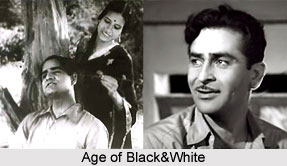 Era of talkies in India led to the introduction of sound; films incorporating synchronized dialogue were acquainted and were known as "talking pictures," or "talkies." The film viewers were bestowed with a surprising gift, the silent era had ended, and films now had sound, so we could hear actors and actresses talking. In 1931 came the first Indian talkie: Alam Ara. It was a costume drama full of fantasy and with many melodious songs to intensify the audience's emotions and it was a stunning success. It was produced by Imperial Movie tone, Bombay. The film was released on 14th March 1931 at Majestic Cinema, Girgaon, Bombay. The film starred Prithviraj Kapoor (father of late Raj Kapoor), Zubeida, Master Vithal, Zillo and Wazir Mohammad Khan. The film had 7 songs and the music director was Firozeshah M. Mistri. The curiosity was irresistible. Crowds thronged to watch Alam Ara, India's first talking movie. The film had an interesting ensemble. The hard work paid off. Alam Ara not only became a runaway success, it also became the template of future.
Era of talkies in India led to the introduction of sound; films incorporating synchronized dialogue were acquainted and were known as "talking pictures," or "talkies." The film viewers were bestowed with a surprising gift, the silent era had ended, and films now had sound, so we could hear actors and actresses talking. In 1931 came the first Indian talkie: Alam Ara. It was a costume drama full of fantasy and with many melodious songs to intensify the audience's emotions and it was a stunning success. It was produced by Imperial Movie tone, Bombay. The film was released on 14th March 1931 at Majestic Cinema, Girgaon, Bombay. The film starred Prithviraj Kapoor (father of late Raj Kapoor), Zubeida, Master Vithal, Zillo and Wazir Mohammad Khan. The film had 7 songs and the music director was Firozeshah M. Mistri. The curiosity was irresistible. Crowds thronged to watch Alam Ara, India's first talking movie. The film had an interesting ensemble. The hard work paid off. Alam Ara not only became a runaway success, it also became the template of future.The second talkie film released in India was Shirin Farhaad, on 30th May 1931. It was produced by Madan Theatres, Kolkata and directed by its owner Mr. J.J. Madan. It had 18 songs. Indra Sabha which was released in 1932 had as much as 69 songs in it! It was produced by Madan Theatre, Calcutta and directed by J.J. Madan. The film starred Master Nissar, Jahan Aara, Kazzam, Miss Silvasia and others. The first ever color film made in India was Kissan Kanhaiya produced by Imperial Film Co. This film was released in 1973. Moti B. Gidwani directed it, and its music was composed by Ram Gopal Pandey. The film had 10 songs, which were released by Gramophone Records.
In that year, 27 films were made in four languages - Hindi language, Bengali language, Tamil language and Telugu language. The introduction of sound generated ever-increasing emphasis on music and song. The phenomenal success of Alam Ara inspired many other directors to follow in its footsteps. Music and fantasy came to be seen as vital elements of the filmy experience. At times, the emphasis on music was overdone. However it is significant that music came to be regarded as a defining element in Indian cinema.
 With the spreading popularity of this new medium of mass entertainment, film directors became more audacious and explored new areas. The 1930s saw the emergence of a fascination with social themes that affected day to day living. V. Shantaram, for example, in his film Amritmantha (1934), held up for scrutiny the theological absolutisms and ritualistic excesses that were gathering momentum at the time, while the landmark Devdas (1935) sought to explore the self-defeating nature of social conventionalist. The character of Devdas has been reincarnated many times in Indian cinema. Jeevana Nataka (1942), another significant film of this period, had as its theme the injurious effects of modernization - a love triangle in which Mohan, driven to alcoholism by his infatuation with the main actress, drives his wife to suicide.
With the spreading popularity of this new medium of mass entertainment, film directors became more audacious and explored new areas. The 1930s saw the emergence of a fascination with social themes that affected day to day living. V. Shantaram, for example, in his film Amritmantha (1934), held up for scrutiny the theological absolutisms and ritualistic excesses that were gathering momentum at the time, while the landmark Devdas (1935) sought to explore the self-defeating nature of social conventionalist. The character of Devdas has been reincarnated many times in Indian cinema. Jeevana Nataka (1942), another significant film of this period, had as its theme the injurious effects of modernization - a love triangle in which Mohan, driven to alcoholism by his infatuation with the main actress, drives his wife to suicide.For more, visit the link below: